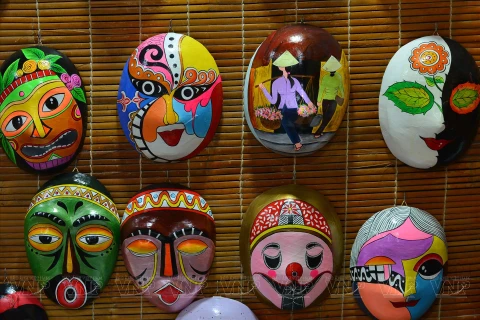
Hanoi (VNA) - The craft of building houses from bamboo trees and coconut leaves in Cam Thanh commune of Hoi An City in the central province of Quang Nam has at times seemed destined to fade away due to new construction materials that are cheap and durable.
Apart from coconut trees, Cam Thanh also boasts an abundant source of bamboo. With these available materials, the craft of building houses from bamboo and coconut leaves has become intertwined with the history of this land.
In a decision dated February 21, 2024, the Minister of Culture, Sports, and Tourism included the local craft in the list of national intangible cultural heritages.
The elderly in Cam Thanh affirmed that the craft dates back to the early 19th century.
Initially, local people built homes for their own families, then took advantage of free time between crops to make houses for others in the village. Gradually, the construction method with bamboo and coconut leaves was formed as an integral part of the region.
This traditional craft, at times, appeared to fall into decline due to the development of new construction materials that are cheap and durable. Furthermore, as the living standards of rural residents improved, the demand for the leaf-based houses decreased, leading many longtime craftsmen to seek alternative livelihoods. Only a few have continued to keep the old practice.
With the rapid development of tourism and the increasing number of visitors to Hoi An city in recent years, the demand for restoring and building traditional houses, eateries, and craft shops from bamboo and coconut leaf materials has been on the rise. As a result, the craft, which has almost sunken into oblivion, has gained the opportunity to revive and thrive.
According to the Hoi An Centre for Cultural Heritage Management and Preservation, to construct a complete bamboo-coconut house, craftsmen must undergo various complex stages, from sourcing necessary materials to processing and crafting finished products. A key material is coconut leaves, harvested in the local coconut groves twice a year in the first and sixth month of the lunar calendar.

In addition to these leaves, another essential material is bamboo trees, which are used to make columns and rafters of the house. Craftsmen usually select those that are neither too young nor too old to ensure good load-bearing capacity.
In the past, in addition to coconut and bamboo, rattan was also used for binding. Rattan was sold at Hoi An market by mountain dwellers from the western part of Quang Nam and Cu Lao Cham island. However, nowadays, the material has been replaced by ropes or plastic strings.

Huts made from bamboo and coconut leaves have advantages over those made from other simple materials. They are durable, lasting from 15 to 20 years, with low production costs.
To be cool in summer and warm in winter, these houses are preferred choices for many residents in Cam Thanh, especially for setting up eateries.
Capitalising on these abundant natural materials, skilled craftsmen in the locality have created other products, such as tables, chairs, beds, cabinets, and shelves. The traditional house-making craft also provides employment opportunities for many local residents.
Hoi An has been named in the UNESCO Creative Cities Network (UCCN) in terms of crafts and folk art since October last year. The city is home to a large number of traditional craft villages, including more than 100 in its ancient quarters alone. Thanks to heritage tourism, Hoi An has so far revitalized many craft villages and folk arts./.























